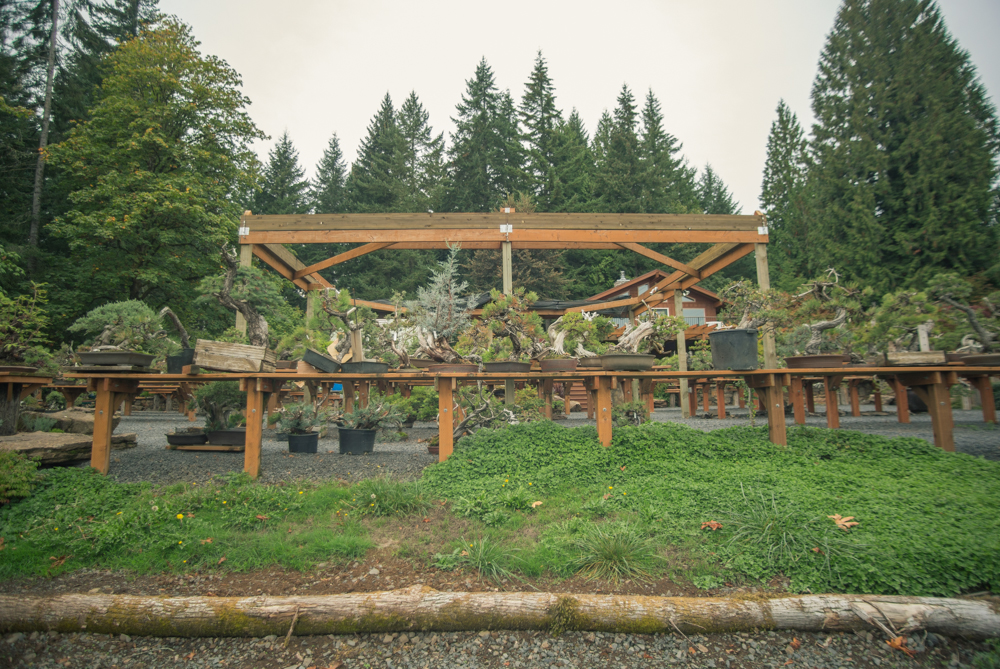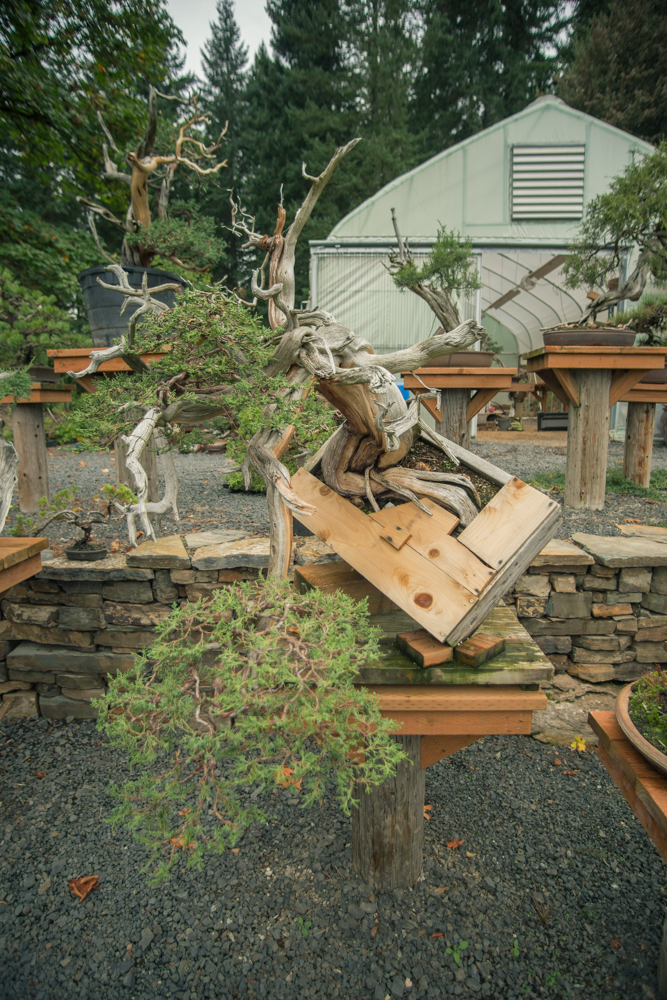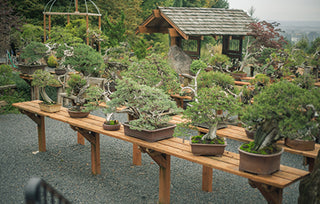The tiny tree nestled in the modest-looking planter before us is more than two thousand years old. It was alive, living and breathing before the common era of humanity – and now, here it is, still thriving, being gazed upon in awe by our team of photographers and journalists amid a vast garden of similar arboreal relics.

Situated at the end of a dirt road up Oregon’s highway 30 in the rolling hill country between Portland and Astoria is Bonsai Mirai. It’s one-part Bonsai garden, one-part school, one-part bed and breakfast – but it’s also the home and workshop of its founder Ryan Neil, his wife Chelsea, and their infant son. Although he’s modest about his craft, Neil is about as knowledged and practiced of a Bonsai artist as they come in the West. He spent six years of his life studying in Japan alongside one of the world’s premiere Bonsai masters – watching, listening, and painstakingly learning the patience and attention to detail it takes to approach a craft so rarely adopted by Westerners.
As its Japanese namesake suggests, “Mirai,” translated literally to English means “tomorrow.” But its linguistic implications in Japanese culture are a little more complex. Mirai is a concept of the future that doesn’t quite exist – it’s the future that will never be. In practice, Mirai is an approach toward the future with the realization that you’ll never quite get there. It’s a constant work in progress – always traveling but never quite arriving. According to Neil, the idea of Mirai is about the most appropriate notion one could apply to the practice of Bonsai – they’re never quite done, you’re never quite done, and the trees stand as perpetual works of art in process for sometimes thousands of years – many times the natural life of any artist who could ever work on them.

Much like humans, Bonsai trees are largely the consequence of their environmental circumstance – the persistence of life personified under the most unusual of conditions. The journey of a Bonsai tree begins in some of the harshest environments for trees on earth – the rocky crags and crevices on the sides of steep mountain cliffs. Seedlings fall into these cracks and the ones that receive just enough soil and water to germinate take hold and spring to life. The result is a tiny tree with the power and soul of something that would have grown to be a thousand times larger if it had been given adequate earth to fully develop. It’s this reflection of environment Neil says is at the heart of Bonsai art.
We caught up with Neil in his garden for a quick interview on a subject matter and process that’s anything but. Here’s some of what he had to say about his life’s passion, his business, and his unique approach to the ancient practice of Bonsai.

CULLEN POYTHRESS: What makes working with Bonsai different than working with other plants?
RYAN NEIL: We’re doing something so counterintuitive and unnatural to these trees. In typical horticulture, you’re usually trying to get a tree not only to grow, but to grow faster and stronger. In Bonsai, you’re trying to get it to slow down. You’re trying to reduce it’s growth, limit it’s root environment and you’re trying to keep it small. It’s completely counterintuitive. In reducing the strength of the tree, you face other issues: Higher susceptibility to insects and disease, higher susceptibility to environmental extremes, and it requires a lot more attention to detail and care in such a confined environment.
In our previous conversations you used the term Shokunin in reference to your teacher in Japan. What is a Shokunin and how does that relate to the practice of Bonsai specifically?
The word Shokunin really just means a professional – but it’s more in the way a professional person is viewed in a culture that puts paramount value on craftsmanship versus a professional that’s based in a culture of capitalism. It’s totally different. So when you start talking about a master or a shokunin, you’re talking about somebody who’s dedicated every single day to mastering a craft and improving not by major leaps or an exponential rise in skill, but by chipping away at the daily discipline and doing the things that aren’t as fun to elevate that art form. It’s all of those incremental steps that people don’t see until ten years later until the jump has been made in their progress. When I was apprenticing, I was learning so much and my skill set just improved exponentially, but by the third year I had slowed down so much that I couldn’t see any improvement. By the sixth year, the growth was small, but it was the most important piece of growth.

What makes a “good” Bonsai? It’s got to be relative, right?
You can look at Bonsai in a lot of different ways. There are trees that are well-built, well-constructed, and the technique applied to the formation to the tree was outstanding. And then there are trees that have a character to them – a special twist in the trunk or a piece of deadwood that’s exceptionally old. The soul and essence of the tree exists in that special feature. So when you look at Bonsai there’s a very wide spectrum of what makes a good Bonsai. But in my opinion, I look for the most unique and most special feature that a species rarely has. For a Pine, it would be a completely hollow trunk – totally rare. For a Juniper, it would be spiraling deadwood. If you construct a tree on top of a really influential piece or special characteristic, then you have something magical.

In the design of these trees, you’ve mentioned that the artistry lies in attempting to reflect or mimic the impact the tree’s natural environment would have had on its shape. What does that mean exactly?
If you’re up at Timberline in the high elevation, you’re going to see trees that are lower to the ground and they’re going to have longer branches blowing in the direction of the wind – the wind is influencing their design. If you have an upright tree at a higher elevation, you’re going to see the branches sloping steeply downward because snow is always pulling them down. But if you go to the coast, you’re going to see branches growing up and out in a broad crown because they don’t have the weight of snow or other harsh conditions. So it’s the way you form that structure and key into those elements that quantify that environment. That’s what in my mind defines the aptitude of the artist.

Much like humans, Bonsai trees are largely the consequence of their environmental circumstance – the persistence of life personified under the most unusual of conditions.
What’s your relationship to these trees? How do you know when you’re done working with them or are you ever? What do you learn from them by working so closely with them for such long periods?
I think about this a lot and this is a question that if I’m not continually asking myself, I’m not paying enough attention. When you look at a tree and ask yourself, “Okay, I’ve styled the tree and it looks beautiful. It’s in a wonderful container and it’s matured into its design – why do I continue to do it? What’s left?” But the thing about it and the thing you start to realize is that age is something you cannot duplicate the impact of. It’s about watching a tree age and being able to compensate for that. You have to able to adapt and adjust and constantly give that tree different things as it continues to grow. You’re always collaborating with the tree because the tree is growing and changing and you’re responding by giving it specific input. The longer you do it, the better the collaboration becomes.

Let’s talk a little bit about the business side of what you’re doing here at Bonsai Mirai. How has your passion for Bonsai intersected with building a business around it? What kinds of services do you provide?
“Mirai” means the future that will never be realized. It’s always tomorrow. Mirai is tomorrow. It’s always the tree that’s not quite finished, and so the design of Bonsai Mirai is to continue to evolve knowing that you’ll never get to that final place. We started out making trees. I traveled nine months out of the year to lecture, demonstrate, do workshops, teach, educate and curate collections. Once we hit the tipping point where we could survive on the income that we made here from tree sales – passing them on to educated individuals because it’s never about the money, it’s about the tree – we started the school here. I stopped traveling because my heart is here making trees. What we want to do now is take Bonsai and develop an educational component for it online so that we can distribute more knowledge to the people that want it without having to physically present. That’s the next step for Mirai.

You’ve made a business out of your passion for Bonsai – but you’re saying that it’s not about the money, it’s always about the trees. What do you mean by that? Do you only sell to select individuals?
You have to think about the fact that some of the trees in the garden are over two thousand years old. If I’m being a patron of a collection of wild trees, I also need to be respectful and responsible for that tree’s existence. So we’ve had a lot of times where we’ve been in financial peril and not made the sale and I hope that we can continue with that. It assures that the trees end up in the right hands. We only sell to students or to people who are accumulating collections we’re curating so we know the people and work with the people. We’re starting to form a lower-end tier for trees around a thousand dollars. They’re not two or three hundred years old and they’re easier to part with.
::
For more information on Bonsai Mirai, visiting the grounds, and Ryan Neil’s work, visit BonsaiMirai.com. Special thanks to Aaron Bengochea for shooting the photos in this article.

